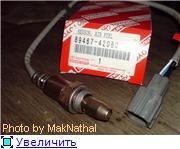admin –њ–Є—Б–∞–ї(–∞):
"–Ъ–Є—Б–ї–Њ—В–Њ–є" –≤ –Ї–Њ–≤—Л—З–Ї–∞—Е, —В.–љ. "–њ–∞—П–ї—М–љ–∞—П –Ї–Є—Б–ї–Њ—В–∞" —Н—В–Њ —А–∞—Б—В–≤–Њ—А ZnCl2. –•–Њ—В—П –≤–Њ–Ј–Љ–Њ–ґ–љ–Њ –Є—Б–њ–Њ–ї—М–Ј–Њ–≤–∞–љ–Є–µ –Є –і–µ–є—Б—В–≤–Є—В–µ–ї—М–љ–Њ –Ї–Є—Б–ї–Њ—В—Л (–Њ—А—В–Њ—Д–Њ—Б—Д–Њ—А–љ–Њ–є, —З—В–Њ –љ—Л–љ—З–µ –і–Њ—Б—В–∞—В–Њ—З–љ–Њ —Н–Ї—Б—В—А–∞–≤–∞–≥–∞–љ—В–љ–Њ).
–Э—Г –і–∞, –њ—А–∞–≤–Є–ї—М–љ–Њ.
MakNathal –њ–Є—Б–∞–ї(–∞):
–Т—З–µ—А–∞ –Ј–∞–Љ–µ–љ–Є–ї–Є –њ–µ—А–µ–і–љ–Є–є –Ј–Њ–љ–і(–љ–Њ–Љ–µ—А –і–∞—В—З–Є–Ї–∞ –њ–Њ–Љ–µ–љ—П–ї—Б—П) 89467-42080
–¶–Є—В–∞—В–∞:
–Ъ–∞–Ї –С–£ –Њ—В–Ї–ї–Є–Ї–љ—Г–ї—Б—П –љ–∞ —Н—В—Г –Ј–∞–Љ–µ–љ—Г? –Ъ–∞–Ї–Є–Љ–Є –њ–∞—А–∞–Љ–µ—В—А–∞–Љ–Є –Њ—В–Љ–µ—В–Є–ї —Н—В–Њ—В —Д–∞–Ї—В (—Б–≤–Њ–µ–є) –ґ–Є–Ј–љ–Є?
–Э–∞—З–Є–љ–∞–µ—В —А–∞–±–Њ—В–∞—В—М –±—Г–Ї–≤–∞–ї—М–љ–Њ —З–µ—А–µ–Ј 3-5 —Б–µ–Ї—Г–љ–і –њ–Њ—Б–ї–µ –Ј–∞–њ—Г—Б–Ї–∞ –і–≤–Є–≥–∞—В–µ–ї—П, –њ–Њ—Б–ї–µ 20 –Љ–Є–љ—Г—В–љ–Њ–≥–Њ –њ—А–Њ—Б—В–Њ—П. –Ф–Є–∞–њ–∞–Ј–Њ–љ —А–∞–±–Њ—В—Л 3.22-3.36 –Т –≤ –Њ—В–ї–Є—З–Є–µ –Њ—В 3.1-3.6 –Т –і–Њ —Н—В–Њ–≥–Њ. –Я—А–Є A/F ratio test –њ–µ—А–і–љ–Є–µ —А–µ–∞–≥–Є—А—Г—О—В —В—Г—В –ґ–µ –њ—А–Є –Њ–±–µ–і–љ–µ–љ–Є–Є —Б–Љ–µ—Б–Є –љ–∞–њ—А—П–ґ–µ–љ–Є–µ –њ–Њ–і–љ–Є–Љ–∞–µ—В—М—Б—П –≤—Л—И–µ 4-—Е –≤–Њ–ї—М—В, –њ—А–Є –Њ–±–∞–≥–∞—Й–µ–љ–Є–Є –њ–∞–і–∞–µ—В –≤ 1.9-2 –Т. –Ч–∞–і–љ–Є–µ –і–∞—З–Є–Ї–Є —А–µ–∞–≥–Є—А—Г—О—В –љ–∞ –Њ–±–µ–і–љ–µ–љ–Є–µ –Є –Њ–±–Њ–≥–∞—Й–µ–љ–Є–µ –≥–і–µ —В–Њ —Б 2-3 —Б–µ–Ї—Г–љ–і–љ–Њ–є –Ј–∞–і–µ—А–ґ–Ї–Њ–є.
–Ъ–Њ–љ—Б—В—А—Г–Ї—Ж–Є—П –і–∞—В—З–Є–Ї–∞ 89467-42080:

(
http://alflash.com.ua/O2/89467_42080.jpg )
-----------------------------------------------------------
Reference.
Toyota RAV4 2GR-FE DTC P0158/P0606
viewtopic.php?f=18&t=481&p=3818&hilit=P0158#p3818Lexus GX460 2011 P0158
viewtopic.php?f=18&t=1080 Lexus GX460 2011 P0158 - 2
viewtopic.php?f=18&t=1094&hilit=target&start=60#p9213 DTC P0606 vs. Oxygen Sensor
http://alflash.com.ua/p0606e.htmLexus RX350 DTC P0138
viewtopic.php?f=18&t=837&p=6903#p6903P.S. P.s. –Р –≤–Њ—В –Ї–∞–Ї —А–µ—И–∞—О—В –њ—А–Њ–±–ї–µ–Љ—Г –њ—А–Њ—Д—Д–Є-–Ј–∞–ї–Є—А—Г—И–љ–Є–Ї–Є. –Ї–Њ—В–Њ—А—Л–Љ –љ–µ–і–Њ—Б—Г–≥ —А–∞p–±–Є—А–∞—В—М—Б—П —Б –і–Є–∞–≥–љ–Њ—Б—В–Є–Ї–Њ–є –њ—А–Є—З–Є–љ –Ї–Њ–і–∞ P0606.
Toyota Landcruiser Prado 120, 05–≥. 4,0L. –љ–µ–Є—Б–њ—А–∞–≤–љ–Њ—Б—В—М –†0606 –њ–Є—Б–∞–ї(–∞):
–Ь–µ—Б—П—Ж–∞ –і–≤–∞ –љ–∞–Ј–∞–і –њ–Њ—Б—В–∞–≤–Є–ї–Є –≥–∞–Ј. –°—В–∞–ї–∞ –њ–Њ—П–≤–ї—П—В—М—Б—П –љ–µ–Є—Б–њ—А–∞–≤–љ–Њ—Б—В—М P0606 - –њ—А–Њ—Ж–µ—Б—Б–Њ—А –±–ї–Њ–Ї–∞ —Г–њ—А–∞–≤–ї–µ–љ–Є—П. –Т –Ї—А—Г–Є–Ј-–Ї–Њ–љ—В—А–Њ–ї–µ —В–Њ–ґ–µ. –Х—Й–µ –≥–Њ—А—П—В –Ј–љ–∞—З–Ї–Є –њ–Њ —Б—В–∞–±–Є–ї–Є–Ј–∞—Ж–Є–Є. –Ъ–ї–µ–Љ–Љ—Г —Б –Р–Ъ–С —Б–љ–Є–Љ–µ—В, –љ–µ–Є—Б–њ—А–∞–≤–љ–Њ—Б—В–Є –њ—А–Њ–њ–∞–і–∞—О—В, –µ–Ј–і–Є—В –љ–µ—Б–Ї–Њ–ї—М–Ї–Њ –і–љ–µ–є, –њ–Њ—В–Њ–Љ –Њ–њ—П—В—М –њ–Њ—П–≤–ї—П—О—В—Б—П. –•–Њ–Ј—П–Є–љ –≥–Њ–≤–Њ—А–Є—В —З—В–Њ —Б –Њ—И–Є–±–Ї–∞–Љ–Є –µ–і–µ—В —В–∞–Ї–ґ–µ –Ї–∞–Ї –Є –±–µ–Ј –љ–Є—Е. –Я–Њ—З–Є—В–∞–ї –њ—А–Њ –Њ—И–Є–±–Ї—Г P0606, –≤—А–Њ–і–µ –Ї–∞–Ї –њ–Њ—П–≤–ї—П–µ—В—Б—П –Є–Ј-–Ј–∞ –Ї–∞—З–µ—Б—В–≤–∞ –±–µ–љ–Ј–Є–љ–∞.
–¶–Є—В–∞—В–∞:
–Ј–∞–Љ–µ—В–Є–ї –Ј–∞–Ї–Њ–љ–Њ–Љ–µ—А–љ–Њ—Б—В—М. P0606 –љ–∞ 120—В—Л—Е —В–∞–Љ –≥–і–µ —Б—В–Њ–Є—В –≥–∞–Ј!–њ—А–Њ–≤–µ—А—П–ї –љ–∞ –Њ–і–љ–Њ–Љ –≤—Б–µ –і–Њ—Б–Ї–∞–љ–∞–ї—М–љ–Њ —В–∞–Ї –Є –љ–µ –љ–∞—И–µ–ї –њ—А–Њ–±–ї–µ–Љ—Г.–і—Г–Љ–∞—О ECM —А—Г–≥–∞–µ—В—Б—П –Є–Ј –Ј–∞ –≤–љ–µ–і—А–µ–љ–Є—П –≤ —Ж–µ–њ–Є —Д–Њ—А—Б—Г–љ–Њ–Ї.
—А–µ—И–∞—О—В "—В—О–љ–Є–љ–≥–Њ–Љ –њ—А–Р—И–Є–≤–Њ–Ї"
–¶–Є—В–∞—В–∞:
–Ґ–Њ–ї—М–Ї–Њ —З—В–Њ –њ—А–Є–µ—Е–∞–ї —Б —В–µ—Б—В–Њ–≤ –љ–∞ –Я—А–∞–і–Њ 4.0 2007 –Р–Ґ. –Ф–Є–∞–≥–љ–Њ—Б—В–Є–Ї–∞ –і–Њ —А–µ–њ—А–Њ–≥–∞: –†0606
–†–µ–њ—А–Њ–≥: –Ґ—О–љ–Є–љ–≥ –Х2.
–Ю—В–Ї–ї—О—З–µ–љ—Л —Д–Є–Ј–Є—З–µ—Б–Ї–Є –Њ–±–∞ –Ф–Ъ2. (–њ—А–Њ–≤–µ—А—П–ї –і–Њ —А–µ–њ—А–Њ–≥–∞, –њ–Њ—П–≤–ї—П–ї–Є—Б—М –љ–µ–Є—Б–њ—А–∞–≤–љ–Њ—Б—В–Є P0057, P0037)
–Ф–Є–∞–≥–љ–Њ—Б—В–Є–Ї–∞ –њ–Њ—Б–ї–µ —А–µ–њ—А–Њ–≥–∞: –љ–µ–Є—Б–њ—А–∞–≤–љ–Њ—Б—В–µ–є –љ–µ—В
–Ь–Њ–ґ–µ—В –њ–Њ—Б–Њ–≤–µ—В–Њ–≤–∞—В—М —Н—В–Є–Љ —Б–њ–µ—Ж–∞–Љ –љ–µ –Ј–∞–Љ–Њ—А–∞—З–Є–≤–∞—В—М—Б—П –Є –њ—А–Њ—Б—В–Њ –Њ—В–Ї–ї—О—З–∞—В—М –Є–љ–і–Є–Ї–∞—В–Њ—А –љ–µ–Є—Б–њ—А–∞–≤–љ–Њ—Б—В–Є?




